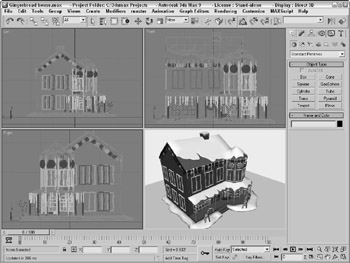Chapter 43: Learning Rendering Basics
After hours of long, hard work, the next step-rendering-is where the "rubber hits the road" and you get to see what you've worked on so hard. After modeling, applying materials, positioning lights and cameras, and animating your scene, you're finally ready to render the final output. Rendering deals with outputting the objects that make up a scene at various levels of detail.
Max includes a Scanline Renderer that is optimized to speed up this process, and several settings exist that you can use to make this process even faster. Understanding the Render Scene dialog box and its functions can save you many headaches and computer cycles. However, other rendering options are available.
The need for all these different rendering engines comes about because of a trade-off between speed and quality. For example, the renderer used to display objects in the viewports is optimized for speed, but the renderer used to output final images leans toward quality. Each renderer includes many settings that you can use to speed the rendering process or improve the quality of the results.
Previewing with ActiveShade
The ActiveShade window gives a quick semi-rendered look at the current scene. You can open ActiveShade within a viewport by right-clicking the viewport title in the upper-left corner of each viewport and choosing Views ![]() ActiveShade from the pop-up menu. Figure 43.1 shows the ActiveShade view visible for the Perspective view.
ActiveShade from the pop-up menu. Figure 43.1 shows the ActiveShade view visible for the Perspective view.

Figure 43-1: The ActiveShade window can be opened within a viewport.
| Caution | The ActiveShade window doesn't display a complete rendered image. Although it includes lighting effects and material maps, it does not include many other features such as Render Effects and Atmospheric effects. |
Only one ActiveShade viewport can be open at a time. If you try to open more than one window, a warning dialog box lets you know that opening it will close the previous window. Right-clicking the ActiveShade window opens a quadmenu of commands. The Render quadmenu in the upper right contains the common rendering menu options. The View quadmenu in the upper left contains the command to close the ActiveShade window.
| Caution | If the active viewport is maximized, then the ActiveShade view option is disabled. |
In the lower-left quadmenu, the Act Only on Mouse Up option waits to update the rendered scene until the mouse is released. If disabled, the window updates immediately. Auto Initialization updates as soon as a new mapped material is applied, and the Auto Update option updates any time a non-mapped material is applied or when the lights are altered.
| Tip | You can drag materials from the Material Editor and drop them directly on the ActiveShade window. |
The Draw Region option (keyboard shortcut, D) changes the cursor to look like a pen. Using this pen cursor, you can select a region in the ActiveShade window by dragging from corner to corner. Within a selected region, only that section is updated. The Initialize option (keyboard shortcut, P) reinitializes the window if the Auto Initialization option isn't enabled. The Update option is a manual update if the Auto Update option isn't selected. The Select Object option lets you pick an object in the ActiveShade window: The selected object is bounded by brackets, and any initialization updates the mapped material on the selected object only.
There is also a command to Toggle Toolbar. The ActiveShade window has access to the same toolbar that is found in the Rendered Frame Window. The buttons on this toolbar are covered in "Using the Rendered Frame Window," later in this chapter.